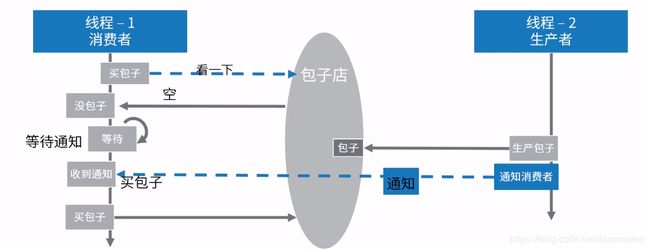java多线程之间的通信
java多线程之间的通信
要实现多个线程之间的协同,如线程执行先后顺序、获取某个线程的执行结果等等。
涉及到线程之间的相互通信,分为下面四类:
1)文件共享
2)网络共享
3)变量共享
4)JDK提供的线程协调API
细分为:suspend/resume、wait/notify、park/unpark
1.文件共享
2.网络共享
尚在学习,之后的博客再作更新。
3.变量共享
4.JDK提供的线程协调API
JDK中对于需要多线程协作完成某一任务的场景,提供了对应的API支持。
多线程协作的典型场景是:生产者-消费者模型。(线程阻塞、线程唤醒)
示例:线程-1去买包子,没有包子,则不再执行。线程-2生产出包子,通知线程-1继续执行。
1)suspend/resume(被弃用)
调用suspend挂起目标线程,通过resume可以恢复线程执行。
/** 正常的suspend/resume */
public void suspendResumeTest() throws Exception {
// 启动线程
Thread consumerThread = new Thread(() -> {
if (baozidian == null) { // 如果没包子,则进入等待
System.out.println("1、进入等待");
Thread.currentThread().suspend();
}
System.out.println("2、买到包子,回家");
});
consumerThread.start();
// 3秒之后,生产一个包子
Thread.sleep(3000L);
baozidian = new Object();
consumerThread.resume();
System.out.println("3、通知消费者");
}
被弃用的主要原因,对使用要求非常严格,容易写出死锁的代码。
a.同步代码中使用
/** 死锁的suspend/resume。 suspend并不会像wait一样释放锁,故此容易写出死锁代码 */
public void suspendResumeDeadLockTest() throws Exception {
// 启动线程
Thread consumerThread = new Thread(() -> {
if (baozidian == null) { // 如果没包子,则进入等待
System.out.println("1、进入等待");
// 当前线程拿到锁,然后挂起
synchronized (this) {
Thread.currentThread().suspend();
}
}
System.out.println("2、买到包子,回家");
});
consumerThread.start();
// 3秒之后,生产一个包子
Thread.sleep(3000L);
baozidian = new Object();
// 争取到锁以后,再恢复consumerThread
synchronized (this) {
consumerThread.resume();
}
System.out.println("3、通知消费者");
}
b.suspend比resume后执行
/** 先执行resume,后执行suspend,导致程序永久挂起,出现死锁 */
public void suspendResumeDeadLockTest2() throws Exception {
// 启动线程
Thread consumerThread = new Thread(() -> {
if (baozidian == null) {
System.out.println("1、没包子,进入等待");
try { // 为这个线程加上一点延时
Thread.sleep(5000L);
} catch (InterruptedException e) {
e.printStackTrace();
}
// 这里的挂起执行在resume后面
Thread.currentThread().suspend();
}
System.out.println("2、买到包子,回家");
});
consumerThread.start();
// 3秒之后,生产一个包子
Thread.sleep(3000L);
baozidian = new Object();
consumerThread.resume();
System.out.println("3、通知消费者");
consumerThread.join();
}
2)wait/notify
只能由同一对象锁的持有者线程调用,也就是写在同步代码块里面,否则会抛出IllegalMonitorStateException异常。
wait方法使当前线程等待,加入该对象的等待集合中,并且放弃当前持有的对象锁。
notify/notifyAll方法唤醒一个或所有正在等待这个对象锁的线程。
注意:虽然会wait自动解锁,但是对顺序有要求,如果在notify被调用之后,才开始wait方法的调用,线程会永远处于WAITING状态。
a.正常输出
1.进入等待
3.通知消费者
2.买到包子,回家
/** 正常的wait/notify */
public void waitNotifyTest() throws Exception {
// 启动线程
new Thread(() -> {
if (baozidian == null) { // 如果没包子,则进入等待
synchronized (this) {
try {
System.out.println("1、进入等待");
this.wait();
} catch (InterruptedException e) {
e.printStackTrace();
}
}
}
System.out.println("2、买到包子,回家");
}).start();
// 3秒之后,生产一个包子
Thread.sleep(3000L);
baozidian = new Object();
synchronized (this) {
this.notifyAll();
System.out.println("3、通知消费者");
}
}
b.死锁输出
3.通知消费者
1.进入等待
…不动了
public void waitNotifyDeadLockTest() throws Exception {
// 启动线程
new Thread(() -> {
if (baozidian == null) { // 如果没包子,则进入等待
try {
Thread.sleep(5000L);
} catch (InterruptedException e1) {
e1.printStackTrace();
}
synchronized (this) {
try {
System.out.println("1、进入等待");
this.wait();
} catch (InterruptedException e) {
e.printStackTrace();
}
}
}
System.out.println("2、买到包子,回家");
}).start();
// 3秒之后,生产一个包子
Thread.sleep(3000L);
baozidian = new Object();
synchronized (this) {
this.notifyAll();
System.out.println("3、通知消费者");
}
}
3)park/unpark
线程调用park则等待“许可”,unpark方法未指定线程提供“许可(permit)”。
不要求park和unpark的调用顺序。
多次调用unpark之后,再调用park,线程会直接运行。
但不会叠加,也就是说,连续多次调用unpark方法,再调用park方法,第一次会拿到“许可”直接运行,后续调用park会进入等待。
注意:park/unpark没有顺序要求,但是park并不会释放锁,所有在同步代码中使用要注意
a.正常情况
/** 正常的park/unpark */
public void parkUnparkTest() throws Exception {
// 启动线程
Thread consumerThread = new Thread(() -> {
if (baozidian == null) { // 如果没包子,则进入等待
System.out.println("1、进入等待");
LockSupport.park();
}
System.out.println("2、买到包子,回家");
});
consumerThread.start();
// 3秒之后,生产一个包子
Thread.sleep(3000L);
baozidian = new Object();
LockSupport.unpark(consumerThread);
System.out.println("3、通知消费者");
}
b.死锁情况
/** 死锁的park/unpark */
public void parkUnparkDeadLockTest() throws Exception {
// 启动线程
Thread consumerThread = new Thread(() -> {
if (baozidian == null) { // 如果没包子,则进入等待
System.out.println("1、进入等待");
// 当前线程拿到锁,然后挂起(锁已经随着线程挂起,获取不到了)
synchronized (this) {
LockSupport.park();
}
}
System.out.println("2、买到包子,回家");
});
consumerThread.start();
// 3秒之后,生产一个包子
Thread.sleep(3000L);
baozidian = new Object();
// 争取到锁以后,再恢复consumerThread
synchronized (this) {
LockSupport.unpark(consumerThread);
}
System.out.println("3、通知消费者");
}
小结
suspend/resume:容易死锁,也容易导致永久挂起。
wait/notify:要求在同步关键字里面使用,免去了死锁的困扰,但是一定要先调用wait,再调用notify,否则会永久等待。
park/unpark:没有顺序要求,但是park并不会释放锁,所有在同步代码中使用要注意。
伪唤醒
警告!之前代码中用if语句来判断,是否进入等待状态,是错误的!
官方建议应该在循环中检查等待条件,原因是处于等待状态的线程可能会收到错误警报和伪唤醒,如果不在循环中检查等待条件,程序就会在没有满足条件结束的情况下退出。
正确示例
public void waitNotifyTest() throws Exception {
// 启动线程
new Thread(() -> {
synchronized (this) {
while (baozidian == null) { // 如果没包子,则进入等待
try {
System.out.println("1、进入等待");
this.wait();
} catch (InterruptedException e) {
e.printStackTrace();
}
}
System.out.println("2、买到包子,回家");
}).start();
// 3秒之后,生产一个包子
Thread.sleep(3000L);
baozidian = new Object();
synchronized (this) {
this.notifyAll();
System.out.println("3、通知消费者");
}
}
伪唤醒时至线程并非因为notify、notifyAll、unpark等API调用而唤醒,是更底层的原因导致的。


